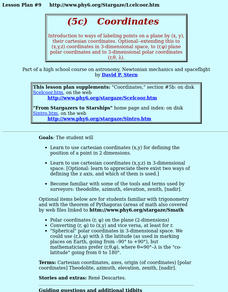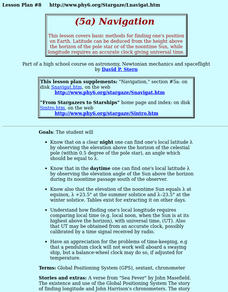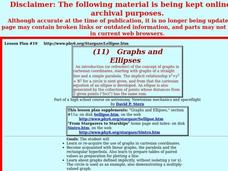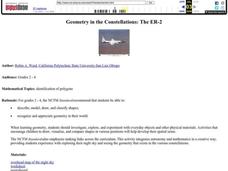Curated OER
Scientific Method
In this scientific method instructional activity, students read and discuss a 2 page article on the scientific method, match 3 founders of the scientific method with what they found or produced, answer 4 statements as true or false, list...
Curated OER
Evaluating Secondary Physical Constants
In this physical constants worksheet, students use fundamental physical constants of nature to determine "secondary" constants. This worksheet has 7 problems to solve.
Curated OER
News to the Core Reported by Very Special Students
Students create news articles that help them build their knowledge, skills, and academic confidence. In this special education lesson, students use previous knowledge to write a newsletter and demonstrate their understanding of various...
Curated OER
Around the World
Students find the circumference of various round objects. For this finding the circumference of various round objects lesson, students find the circumference of the Earth. Students find the circumference of trees, tires, and other...
Curated OER
Similar Right Triangles-Introductions to Trigonometry
In this geometry worksheet, students examine similar right triangles as the basis for the foundation of trigonometry. Students define the basic trigonometric functions and use a calculator to find the trigonometric value of an angle. The...
Curated OER
Ellipses And Kepler's First Law
High schoolers explain that planets actually orbit the center of gravity of the solar system, and that distant planets may be detected by motions of their central star around the centers of gravity of their planetary systems.
Curated OER
How Distant is the Moon?--2
Pupils examine total eclipses of the Sun and their limited regions of totality. They explain that this limited view occurs because the Moon is close enough to us for different points on Earth to view it differently.
Curated OER
How Distant Is The Moon?
High schoolers discover how Aristarchus, a Greek astronomer around 230 BC, used a simple observation of the eclipse of the Moon, plus clever reasoning, to deduce the distance of the Moon. They practice the same calculation technique.
Curated OER
Parallax
High schoolers discover how astronomers used the diameter of the Earth's orbit around the Sun as a baseline for estimating the distance of some stars, and the meaning of "Parsec" and "light year."
Curated OER
Coordinates
Students use cartesian coordinates (x,y,z) in 3-dimensional space. [Optional: appreciate there exist two ways of defining the z axis, and which of them is used.] They become familiar with the tools and terms used by surveyors.
Curated OER
Navigation
Young scholars study the basic methods for finding one's position on Earth. Latitude can be deduced from the height above the horizon of the pole star or of the noontime Sun, while longitude requires an accurate clock giving universal time.
Curated OER
Graphs and Ellipses
Students explore linear graphs, the parabola and the rectangular hyperbola.
Curated OER
Kepler's Third Law
Students use Kepler's third law to derive the velocity in a circular orbit of any radius, and identify the Earth escape velocity.
Curated OER
Popcorn Neutrino Lab
Students parcticipate in a modeling activity that simulates the cyclical role of experimental and theoretical science. Initially, students measure the mass of popcorn. They also record predictions of the mass of the kernels after they...
Curated OER
Follow The Falling Meteorite
Students investigate the supposed traveling path of a meteorite. They use sound in order to triangulate the path. The results of the experiment are written on a map to display the path of the meteorite. The culminating activity is when...
Curated OER
Geometry in the Constellations: The ER-2
Learners discuss reasons to record the location of stars. They view a picture of the night sky, and discuss constellations. Students complete a worksheet of the various shapes they see in the constellations.
Other popular searches
- Astronomy and Space Science
- Astronomy Vocabulary
- Planets and Astronomy
- Astronomy Activity
- Science Astronomy
- Ancient Astronomy
- Astronomy Lesson Plans
- History of Astronomy
- Space Science Astronomy
- Space and Astronomy
- Astronomy Navigation
- Astronomy History


















